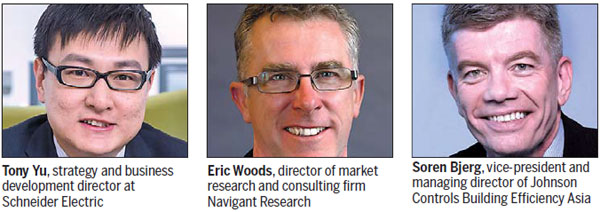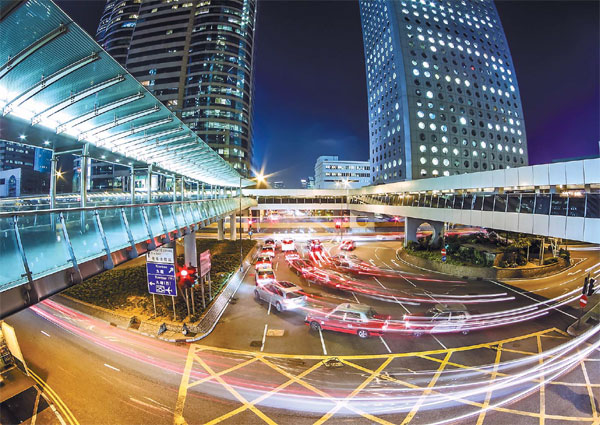Smart steps to greener future
Updated: 2015-03-06 07:48
By Cecily Liu(China Daily Europe)
|
|||||||||||
New technologies and partnerships with multinational firms help address pollution and sustainability issues in China
Smart city solutions are becoming an increasingly popular approach to tackle the challenges of climate change, and China's commitment in introducing these technologies could make the country a leader in the concept. Relatively new smart city solutions generally use technology to identify the sources of pollution or resource inefficiency in cities, and help policymakers create the right strategy to address these issues.
Global firms like IBM, Schneider, Honeywell and Johnson Controls are bringing in their own technological solutions to China, as well as creating unique ways to address China's pollution issues.
|
A view of Central in Hong Kong. Photos provided to China Daily |

One key example is a 10-year project jointly developed by IBM and the Beijing government. Known as Green Horizon, the project will employ sensor technologies, big data analytics, weather modeling, and other advanced techniques to help the city monitor and address air pollution.
Eric Woods, director at market research and consulting firm Navigant Research, says such commitment and efforts in China means in the future Western cities may look to China as a leader in air quality improvement.
In 2013, the Chinese government launched its Airborne Pollution Prevention and Control Action Plan, which will see it invest $277 billion in an attempt to reduce air pollution by up to 25 percent in selected provinces and cities, including Beijing, by 2017 compared to 2012 levels. Beijing alone is expected to invest around $160 billion.
Woods says smart city solutions are helpful in allowing cities to focus on economic growth, but at the same time do as much as they can to achieve sustainability.
This is because these technologies can identify the sources of pollution in cities so that appropriate action can be taken to directly address these pollution sources efficiently, rather than tackling pollution with a large variety of measures that restrict fast economic growth.
"Smart city solutions are sustainable solutions that will continue to improve people's quality of life. They will focus on providing good services in cities, sustainability and continued economic growth," Woods says.
"The issue of pollution is a byproduct of economic activities, as people travel to cities and build houses to live in. But there are ways of reducing pollution by identifying their sources, and creating the right strategy to tackle the pollution," he says.
Therefore smart city solutions could be the creation of public transport, or encourage electric cars to reduce petrol and diesel pollution.
"The challenge is how you integrate all this information into a decision. If you are monitoring the air quality, and you know the causes of the air pollution, you can make changes in terms of road access, avoid using vehicles and drop prices in the transit system," Woods says.
Smart city solutions have also gained popularity in the West in recent years, although many focus on maintaining the competitiveness of old city centers and meeting energy reduction goals.
In Europe, the concept is an important part of Horizon 2020, a European Union initiative that aims to secure Europe's global competitiveness.
Nikolaos Kontinakis, project coordinator of Eurocities, a network that supports local governments, says European and Chinese cities have a lot to share with each other in terms of smart city solutions.
He says Europe and China face similar problems of environmental pollution, and many smart city technologies can help to address these issues, including green building, traffic control and energy solutions.
"I think although European cities do not seem to have as obvious or visible environmental pollution, they face the same challenges as Chinese cities. Both need cleaner cars, traffic improvement and other solutions. Smart city technology can allow these to happen by changing people's behavior," says Kontinakis.
"Chinese cities are good at adapting to new technologies and upscaling the size of projects and new solutions. This is because China's urbanization is happening very fast, and in a few years many big cities have been and will be formed," he says.
In 2013, Eurocities helped organize the EU-China Urbanization Forum, which attracted mayors of around 40 European and Chinese cities to share their experiences and expertise on smart city technologies.
The delegates discussed sustainable mobility, smart cities, urban innovation, culture heritage and urban planning with the objective of exchanging best practices that can be replicated both in China and Europe.
A new project, EC-Link, was formally launched at the forum, which aims to establish urban, low-carbon partnerships between Chinese and European cities. Chinese cities will be able to draw on the knowledge of experts in European cities, while Europe will be able to access results from ongoing projects in China.
Eurocities has become an important partner in EC-Link, responsible for peer-to-peer learning activities and visibility events between European and Chinese cities.
A large number of Eurocities member cities, including Barcelona, Bonn, Bristol, Ghent and Turin, are already actively cooperating with Chinese cities on smart city initiatives.
Many Western companies have also taken their smart city capabilities and technologies to China, and developed locally suitable solutions.
One example is the French company Schneider. Schneider Electric has led and participated in many smart city projects in China, in particular in the fields of transport management, water management and green buildings.
One example is a traffic control system Schneider Electric has implemented in Beijing to better manage traffic flows, and therefore reduce vehicle emissions.
The system has been integrated in 10 control centers, containing different aspects of traffic control including traffic signals, high-definition enforcement system, supervision and monitoring system for expressways, CCTV, traffic flow detection, and a weather detection and guidance system.
Another key example is the implementation of smart grids in Chinese cities, including Tianjin and Guiyang. In Tianjin, Schneider Electric has upgraded the city's existing power grid to a smart grid, which also includes a district heating management system and a metro tolling system.
Guiyang's smart grid collects and analyzes real-time operational data across a distribution network covering 4 million people in the city.
Tony Yu, strategy and business development director at Schneider Electric, says smart city technology can address many problems and challenges in the world as the population grows.
"We hope that smart city solutions can design the proper infrastructure of an economy so it can lead to proper and long-term economic development," Yu says, adding that at Schneider Electric the focus on building smart cities is on livability, sustainability and efficiency.
Efficient means improving the efficiency of a city's underlying urban infrastructures, while livable means becoming a more pleasant place to live, work and play - for its residents as well as for its visitors and commuters.
Sustainable means reducing the environmental consequences of urban life - reducing the city's carbon emissions, regenerating districts, planting trees, creating parks and planning the city differently.
Yu says smart city projects contribute toward pollution reduction in a small way, as they help energy and resources to be better managed and used more efficiently. In some areas, the energy reduction can be huge, such as the building and industry sectors, where smart city solutions can lead to up to 30 percent in energy reductions.
Yu says many of Schneider's smart city solutions for the China market are designed specifically for this market through local research and development effort, with support of global R&D expertise.
"As a company we greatly value R&D, which means that 5 percent of our total sales will go into R&D, and a lot of it will go into smart city solutions," Yu says.
He says many Western-developed R&D solutions will undergo minor modifications in the Chinese market to develop the locally suitable solution, and on the other hand many of the solutions developed in China are then also used in international markets.
For example, smart water management is an area that many Western countries have started to develop early, which Chinese cities have then taken the solutions and adapted toward their local needs.
"We have successfully shared this technology with China. In China a lot of water is wasted in the process of using them, and this water can be saved by using technology," he says.
Yu says China's smart city technologies have great potential for future growth, because the Chinese government has placed great emphasis on the concept in the past few years and the country has already led the development of many of these technologies.
"In China, there are many areas with great potential to develop and improve smart city technologies, including energy, transport systems, water, public services and buildings," he says.
Looking into the future, Yu says the future development of integration between operational technology and information technology to provide cities with effective management systems, and citizens with better public and innovative private services.
However, there are still many challenges to smart city solutions, especially as the area is so new, and many people are still getting used to the very concept of it, Yu says.
"One challenge is the need for a new approach that combines public governance, people ownership and business collaboration, drawing together different parties allowing to work toward a common goal," he says.
"The other challenge is to have a collaborative mindset from different departments working on the same project," he says.
Globally, Schneider Electric is in charge of urban projects in over 250 cities across a variety of countries, including Brazil, China, India, Europe and the United States. These projects all improve the efficiency of urban systems in different ways - from energy to water to transportation.
Another example is the US company Johnson Controls, which leads in green building products and solutions, providing building automation systems and heating, ventilation and air-conditioning systems.
Recently, Johnson Controls used its building technology and consulting expertise to help the Northstar Delta Office Tower, a 79,000-square-meter office tower, in Changsha, Hunan province, earn two prestigious green building certifications and cut energy consumption by 28 percent.
"With some 40 percent of energy worldwide consumed in buildings, optimizing the building energy efficiency goes a long way in optimizing a city's energy efficiency," says Soren Bjerg, vice-president and managing director of Johnson Controls Building Efficiency Asia.
Bjerg says Johnson Controls has also developed many solutions for the Chinese market. For example, the waste heat recovery solution is spearheaded and developed in China, and this has huge potential for other big cities that require heating.
Last year, the company opened a $35 million expansion of its manufacturing and research and development center in Wuxi, Jiangsu province. The campus and its engineering center is now one of Johnson Controls' largest research and development centers in the world for building solutions for heating, ventilation and air conditioning systems, as well as industrial refrigeration solutions, Bjerg says.
The US firm Honeywell has already built its integrated R&D platform across businesses in China. In 2014, it generated more than 600 inventions and 90 patents locally, and a large portion of these are around energy efficiency, quality of life, safety and public security, which are closely linked to smart cities.
Honeywell is also working on a number of successful smart city projects across the country. In Tianjin, it partnered with Tianjin Economic-Technological Development Area to design and implement the country's first Smart Grid Demand Response pilot project.
This project will help China develop a nationwide set of smart grid industry standards and regulations. In Beijing, Honeywell also provided intelligent, integrated building solutions and air purifying solutions to Wangjing SOHO to help create an efficient landmark.
It is also working with Chinese companies from various sectors to boost the development of smart cities, include power distributors, automakers, banks, hospitals, airports, hotels, property developers, retailers and metro operators.
Stephen Shang, president and CEO at Honeywell China, says that urbanization, green economy and new technologies are significant forces that will affect China over the next five to 10 years, and that smart cities is at the core of these macro trends.
"We've seen quite a few Chinese cities put forward their smart city development plans and goals. We expect the development of smart cities in China is going to embark on a new stage, from planning to implementation. And thanks to the scale and speed, China will become a pioneer and global leader on this front," Shang says.
cecily.liu@chinadaily.com.cn
( China Daily European Weekly 03/06/2015 page16)
Today's Top News
Bright Food continues with overseas expansion
China lowers annual GDP growth target to 7%
China faces 'formidable challenges'
Diplomats talk about 'two sessions'
US ambassador to S.Korea attacked
Belgian royal couple to visit China
China faces 'formidable challenges', says Li
China's defense budget to rise about 10%
Hot Topics
Lunar probe , China growth forecasts, Emission rules get tougher, China seen through 'colored lens', International board,
Editor's Picks

|

|

|

|

|

|






